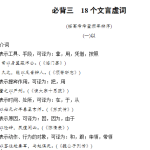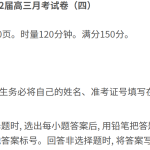重庆市南开中学2020-2021学年下学期高三第二次高考模拟英语试题
重庆市南开中学2020-2021学年高三第二次高考模拟
英语试题
注意事项:
1.答卷前,考生务必将自己的姓名、考生号、考场号、座位号填写在答题卡上。
2.回答选择题时,选出每小题答案后,用铅笔把答题卡上对应题目的答案标号涂黑。如需改动,用橡皮檫干净后,再选涂其他答案标号。回答非选择题时,将答案写在打题卡上,写在试卷上无效。
3.考试结束后,将本试卷和答题卡一并交回。
第一部分 听力
做题时,先将答案标在试卷上。录音内容结束后,你将有两分钟的时间将试卷上的答案转涂到答题卡上。
第一节
听下面5段对话。每段对话后有一个小题,从题中所给的A、B、C三个选项中选出最佳选项。听完每段对话后,你都有10秒钟的时间来回答有关小题和阅读下一小题。每段对话仅读一遍。
例:How much is the shirt?
- £19.15.B. £9.18. C. £9.15.
答案是C。
1.What does John find difficult in learning German?
A .Pronunciation. B. Vocabulary. C. Grammar.
2.What is the probable relationship between the speakers?
- Colleagues.
- Brother and sister.
- Teacher and student.
3.Where does the conversation probably take place?
- In a bank.B. At a ticket office. C. On a train.
- What are the speakers talking about?
A.A restaurant. B.A street. C.A dish.
5.What does the woman think of her interview?
- It was tough.B. It was interesting. C. It was successful.
第二节
听下面5段对话或独白,每段对话或独白后有几个小题,从题中所给的A、B、C三个选项中选出最佳选项。听每段对话或独白前,你将有时间阅读各个小题,每小题5秒钟;听完后,各小题将给出5秒钟的作答时间。每段对话或独白读两遍。
听第6段材料,回答第6、7题。
6.When will Judy go to a party?
- On Monday.B. On Tuesday. C. On Wednesday.
7.What will Max do next?
- Fly a kite. B. Read a magazine. C. Do his homework.
听第7段材料,回答第8、9题。
8.What does the man suggest doing at first?
- Going to a concert.
- Watching a movie.
- Playing a computer game.
9.What do the speakers decide to do?
- Visit Mike. B. Go boating.C. Take a walk.
听第8段材料,回答第10至12题。
10.Which color do cats see better than humans?
- Red.B. Green. C. Blue.
11.Why do cats bring dead birds home?
- To eat them in a safe place.
- To show off their hunting skills.
- To make their owners happy.
12.How does the man sound at the end of the conversation?
- Grateful.B. Humorous. C. Curious.
听第9段材料,回答第13至16题。
13.Who is Macy?
- Ed’s mother.B. Ed’s teacher. C. Ed’s friend.
14.How does Ed usually go to kindergarten?
- By car. B. On foot. C. By bus.
15.What does Ed enjoy doing at the kindergarten?
- Telling stories. B. Singing songs . C. Playing with others.
16.What do the teachers say about Ed?
- He’s clever. B. He’s quiet. C. He’s brave.
听第10段材料,回答第17至20题。
17.At what age did Emily start learning ballet?
- Five. B. Six. C. Nine.
18.Why did Emily move to Toronto?
- To work for a dance school.
- To perform at a dance theater.
- To learn contemporary dance.
19.Why did Emily quit dancing?
- She was too old to dance.
- She failed to get a scholarship.
- She lost interest in it.
20.How does Emily feel about stopping training?
- She’s pleased.B. She’s regretful. C. She’s upset
第二部分 阅读
第一节
阅读下列短文,从每题所给的A、B、C和D四个选项中,选出最佳选项。
A
It can be tough to pull kids away from their computers and mobile devices these days. While they’ re playing games, wouldn’t it be great if they could be learning at the same time? Good educational apps offer fun challenges that teach specific grade – level skills. Here are four that combine fun and learning.
Understanding Math ( $ 3.99 ; iOS)
Understanding Math goes beyond basic comprehension to gain a deeper understanding of the whys and hows of math. The app tracks your child’s progress to determine strengths and weaknesses in different skill areas, and you can customize (订制) your child’s learning experience to suit the needs.
Word Creativity Kit ( $2.99; iOS)
Word Creativity Kit aims not only to make creative writing fun but also build up grammar rules. The app presents a series of words from seven categories, such as space or fantasy. Kids add their own words to finish the complete thoughts that these words have inspired.
Barefoot World Atlas ( $4.99; iOS)
Barefoot World Atlas helps kids learn about geography and world cultures with a touch of the screen. Each region features a set of sub – topics, from wildlife and natural features to native people ,landmarks, and architecture. These facts and illustrations are delivered in photographs, sounds, and hundreds of mini videos.
My Grades & Homework ( $0.99; iOS)
A combination of grades and homework tracker, My Grades & Homework can help your child stay organized and on top of the progress in school. A convenient calendar and course list format and offer a glance at your child’ s assignment schedule that he or she might not normally get from standard homework planners.
- Which app is beneficial to children’s writing skills?
- Understanding Math. B. Word Creativity Kit.
- Barefoot World Atlas. D. My Grades Homework.
- What is the common part of the four apps?
- They need purchasing when downloaded.
- They help children improve their grades.
- They make studies fun because of mini videos.
- They inform parents of their children’s progress.
- What is the purpose of the text?
- To wish readers to bring in more similar apps for children.
- To encourage parents to allow their students to play apps.
- To design the educational apps to combine fun and learning.
- To introduce four educational apps for readers to buy and use.
B
No one knows who invented the button. It has existed as early as 2000 BC. When it first started, it was just something pretty yet replaceable sewn onto your clothes. About 3,000 years later, someone finally invented the buttonhole, and buttons were suddenly useful and applied to clothes universally.
Before buttons, clothes were bigger — they had no fixed shapes. People felt as if they wrapped themselves in things. Because of the buttonhole, the fashion moved closer to the body as we discovered uses for the button. At one time, ifs the very way to make clothes fit well for the body. People are completely secure.
The pattern of a button hasn’t changed much since the Middle Ages. It’s one of the most lasting designs in history, because it actually works to keep our clothes shut. Zippers easily break and are hard to fix. Velcro is rackety,and it wears out after a while. However, if a button breaks, you just exactly sew another on. And you can do up your buttons without disturbing others.
A button is there for the long run. It’s not just the most important design ever, but it’s thought to be a decisive factor in the development and innovation of clothes. Present design of clothes shows its influence obviously. If you’re wearing a take a look at the position of buttons on it. If you’re a male, the buttons would likely be on the right side, but for a female, the buttons are usually found on the left.
Once the buttons were all on the right, and the trend of buttons-on-the-left was set by wealthy women of the Victorian era. Their clothes were complex, consisting of corsets, petticoats, buttons and a wide range of beautiful accessories(配饰). Therefore, they needed assistance while getting dressed. Keep this in mind, clothing makers made innovation and designed articles of clothing that were simple for servants to button up. Such designs of clothing became more and more popular over time, and eventually became the standard still being followed to this day.
- What can be learnt about early buttons in the first paragraph?
- They appeared a bit later than buttonholes.
- They served as an essential part of the clothes.
- Their popularity was driven by buttonholes greatly.
- They were invented by someone unknown accidently.
- What does the underlined word “rackety” in paragraph 3 mean?
- Decorative. B. Practical. C. Expensive. D. Noisy.
- Why did the design of buttons on women’s clothes change in the Victorian era?
- To innovate old designs of clothes.
- To make it easier to button up.
- To beautify the clothes of women.
- To keep the standard widely followed.
- Which can be the title of the text?
- How buttons changed fashion
B What the real role of buttons is
- Why buttons were invented
- When buttons came into sight
C
A tiny Alaska village has experienced a boom in tourism in recent years as polar bears spend more time on land than on Arctic sea ice.
More than 2,000 people visited the northern Alaska village of Kaktovik in 2018 to see polar bears in the wild. The far north community lies in an area where increasingly higher temperature has sped up the movement of sea ice, the primary habitat(栖息地) of polar bears. As ice has gradually moved to deep water beyond the continental shelf, more bears are remaining on land to look for food.
Polar bears have always been a common sight on sea ice near Kaktovik, but villagers started noticing a change in the mid-1990s. More bears seemed to stay on land, and researchers began taking note of more female bears making homes in the snow on land instead of on the ice to raise their babies. U. S. Fish and Wildlife Service biologists began hearing reports of the increasing number of polar bears in the area in the early 2000s. As more attention was given to the plight (困境)of polar bears about a decade ago, more tourists started heading to Kaktovik.
The village had fewer than 50 visitors annually before 2011, said Jennifer Reed, of the Arctic National Wildlife Refuge. “Today we’re talking about hundreds and hundreds of visitors, many from around the world each year,” Reed said. Most tourists visit in the fall, when bears are forced toward land because sea ice is farthest away from the shore. Bruce Inglangasak, a local hunter who sometimes offers wildlife-viewing tours, said been offering polar bear tours since 2004. Most of his clients(客户) are from China and Europe, as well as from the lower 48 U. S. states. Many tourists stay several days in the village, which has two small hotels. The villagers have benefited a lot from that. In turn, they provide more effective protection for polar bears with financial support from tourism development.
- What causes more polar bears to stay on land in Kaktovik?
A Food shortage. B. Climate change.
- Habitats, movement to shore. D. Their preference for land.
- How did common people feel about more sight of bears on land?
- Excited. B. Puzzled. C. Concerned. D. Shocked.





